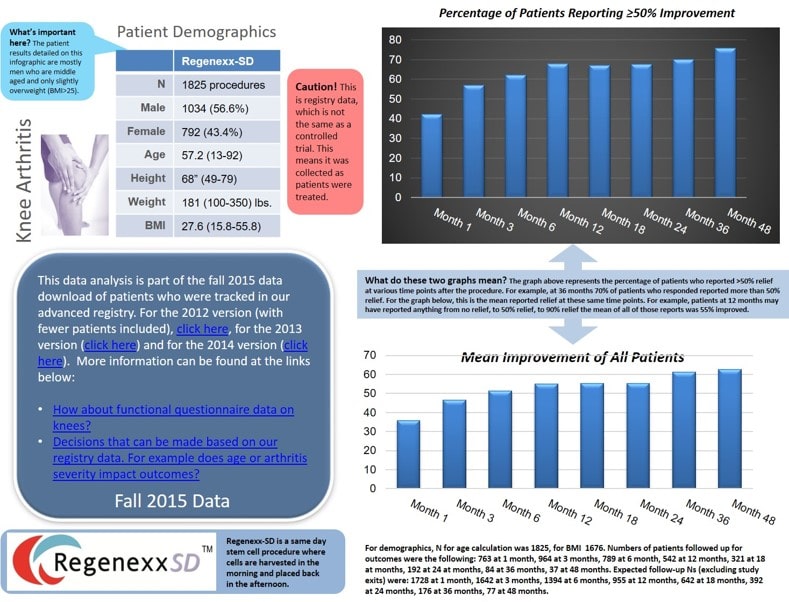Knee Stem Cell Research: 2015 Regenexx-SD Data
Knee stem cell research is still sparse in 2015. We’ve been collecting registry data for the last decade on the various stem cell procedures we offer. You would have thought that by now that we would have seen many other clinics and provider networks transparently publishing their data on knee stem cell injections. However, every year that I publish our even expanding group of knee arthritis patients treated with the proprietary Regenexx-SD stem cell procedure, I’m a bit disappointed by the fact that we seem to be the only ones doing this at any reasonable scale.
This morning I’d like to announce that we have performed 1,825 Regenexx-SD procedures on knee arthritis patients. This is by far the largest human experience reported using a stem cell therapy on patients with knee problems. In fact, there isn’t even a close second within a thousand patients. The data continues to show that the results look good. However, it’s also important to note that this is data collected as patients are being treated and is not a drug company style randomized controlled trial.
Above you can see two graphs off to the right (click here to see a larger PDF image). They measure the patient’s report of percentage improvement from -100% worse to +100 better. The first is the percentage of patients who report more than 50% improvement. You’ll see this tends to go up over time, but as with my comments last year, I don’t believe that this represents the knee getting better and better as the years progress. Instead, it’s likely the effect of patients who have sought other options dropping out of reporting their results back because they needed a knee replacement despite our treatment. When this happens we close the patient’s registry file as we don’t want to include the results of their knee replacement in this data that tracks the results of their knee stem cell injection.
The second graph (lower right) is the mean percentage improvement. This likely has the same issue as described above. In particular, note that this is the mean of the report of all patients at these time points. Hence, if we take for example the 24 month mean of 55%, this number is the weighted average of everyone who reported at 2 years after their procedure, which might have patients who didn’t improve and reported a 0%, patients who reported 50%, and patients who reported 100% improvement. In particular, it doesn’t mean that all patients reported 55% improvement.
The upshot? Collecting all of this data is expensive and time consuming. However, when you’re looking at options for treating your knee arthritis with stem cell injections, ask yourself why this kind of data isn’t available on other web-sites advertising this type of treatment. Where’s the beef?

If you have questions or comments about this blog post, please email us at [email protected]
NOTE: This blog post provides general information to help the reader better understand regenerative medicine, musculoskeletal health, and related subjects. All content provided in this blog, website, or any linked materials, including text, graphics, images, patient profiles, outcomes, and information, are not intended and should not be considered or used as a substitute for medical advice, diagnosis, or treatment. Please always consult with a professional and certified healthcare provider to discuss if a treatment is right for you.
